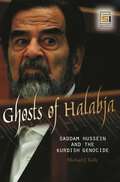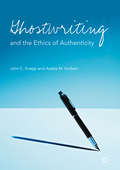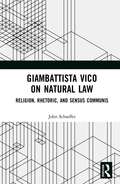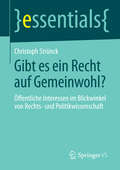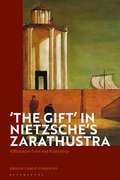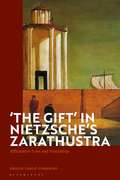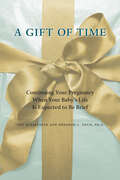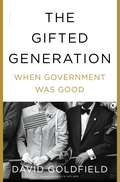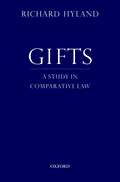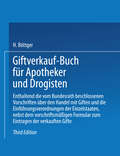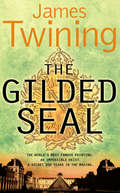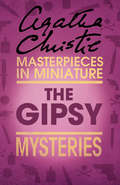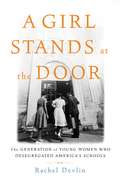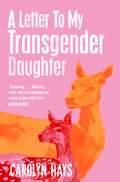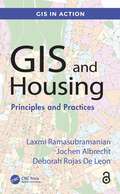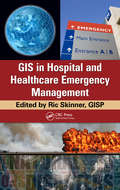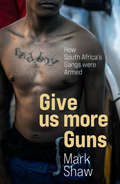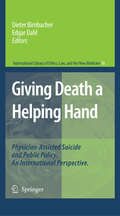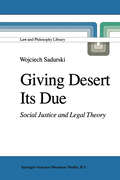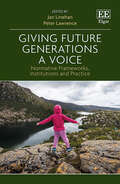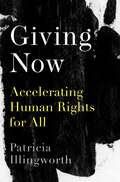- Table View
- List View
Ghosts of Halabja: Saddam Hussein and the Kurdish Genocide (Praeger Security International)
by Michael J. KellySaddam Hussein's execution for his crimes against Iraq's Shia not only brought an end to his reign of oppression, but also to the justice that was to be served to the Iraqi Kurds. The unspeakable atrocities visited by Saddam upon the Kurds of Iraq are explored here, together with the trials of Saddam by the Iraqi High Tribunal. However, this work is more than a litigation history. It is also an exploration of the motivations behind and the depths of organized evil in the context of a single, brutal despot at the helm of an artificially created multi-ethno/religious state lying atop massive oil wealth. Saddam's background and the context of his rule explain much about his actions, but not all. He remained an unpredictable tyrant to the end of his reign.The Kurds have continually been subject to adversity since the end of World War I, when they were denied their own homeland, splitting them among three countries: Turkey, Iran, and Iraq. During Saddam's 24-year reign, the Kurds of Iraq were frequently under the knife of injustice. Between 1987 and 1989, Saddam unleashed genocide, razing over 2,000 villages and murdering at least 50,000 Kurds. As his dictatorship came to an end, the Kurds long-awaited opportunity to hold Saddam responsible for the atrocities against them seemed to have come, only to be sidetracked by the Iraqi High Tribunal, the Iraqi government, and the U.S. government. While the Shia rejoiced in their victory, the Kurds continued to be left behind. Saddam's death freed him of the charges against him by the Kurds. The world had turned its back on the Kurds in their age of genocide, and now appeared to turn a blind eye to the justice that was denied.The unspeakable atrocities visited by Saddam upon the Kurds of Iraq are explored here together with the trials of Saddam by the Iraqi High Tribunal—both the completed prosecution for the Dujail massacre against the Shites and the incomplete one for the Anfal Campaigns against the Kurds. However, this work is more than a litigation history. It is also an exploration of the motivations behind and the depths of organized evil in the context of a single, brutal despot at the helm of an artificially created multi-ethno/religious state lying atop massive oil wealth, but situated in the most dangerous part of the world. Saddam's background and the context of his rule explain much about his actions, but not all. He remained an unpredictable tyrant to the end of his reign.
Ghostwriting and the Ethics of Authenticity
by John C. Knapp Azalea M. HulbertThis book presents an ethical framework which evaluates the legitimacy of the practice of ghostwriting. It explores the connection between personal authenticity and the use of ghostwriters in corporate, political, legal, higher education, and scientific contexts. It then examines the history of ghostwriting as a professional practice and introduces a model for ethical analysis.In this book, the authors shrewdly address crucial ethical questions such as: When is it acceptable for a leader to claim the words of a ghostwriter as their own? When may this be inappropriate or even dangerously misleading? What are the consequences when public awareness of this practice leads to cynicism about the authenticity of leaders and their communications? And when, if ever, is the use of a ghostwriter ethical? This book will be welcomed by scholars and practitioners alike as an original and timely contribution to the literature of business, politics, and communications.
Giambattista Vico on Natural Law: Rhetoric, Religion and Sensus Communis
by John SchaefferThis book introduces the thought of Giambattista Vico (1668-1744) into the discussion about natural law. For many critics, natural law is not natural but a façade behind which lurks the supernatural – that is, revealed religion. While current notions of natural law are based on either Aristotelian/Thomistic principles or on Enlightenment rationalism, the book shows how Vico was the only natural law thinker to draw on the Roman legal tradition, rather than on Greek or Enlightenment philosophy. Specifically, the book addresses how Vico, drawing his inspiration from Roman history, incorporated both rhetoric and religion into a dynamic concept of natural law grounded in what he called the sensus communis: the entire repertoire of values, images, institutions, and even prejudices that a community takes for granted. Vico denied that natural law could ever furnish a definitive answer to moral problems in the social/public sphere. Rather he maintained that such problems had to be debated in the wider arena of the sensus communis. For Vico, as this book argues, natural law principles emerged from these debates; they did not resolve them.
Giambattista Vico on Natural Law: Rhetoric, Religion and Sensus Communis
by John SchaefferThis book introduces the thought of Giambattista Vico (1668-1744) into the discussion about natural law. For many critics, natural law is not natural but a façade behind which lurks the supernatural – that is, revealed religion. While current notions of natural law are based on either Aristotelian/Thomistic principles or on Enlightenment rationalism, the book shows how Vico was the only natural law thinker to draw on the Roman legal tradition, rather than on Greek or Enlightenment philosophy. Specifically, the book addresses how Vico, drawing his inspiration from Roman history, incorporated both rhetoric and religion into a dynamic concept of natural law grounded in what he called the sensus communis: the entire repertoire of values, images, institutions, and even prejudices that a community takes for granted. Vico denied that natural law could ever furnish a definitive answer to moral problems in the social/public sphere. Rather he maintained that such problems had to be debated in the wider arena of the sensus communis. For Vico, as this book argues, natural law principles emerged from these debates; they did not resolve them.
Gibt es ein Recht auf Gemeinwohl?: Öffentliche Interessen im Blickwinkel von Rechts- und Politikwissenschaft (essentials)
by Christoph StrünckPolitikwissenschaftliche Pluralismustheorien betrachten Gemeinwohl als Resultat politischer Kompromisse. Solche prozeduralen Konzepte finden sich auch in der Rechtswissenschaft, wenn es darum geht, allgemeinen und schwachen Interessengruppen besondere Klagerechte einzuräumen. Allerdings müssen Gerichte in ihren Urteilen inhaltlich begründen, inwiefern mit solchen Klagen öffentliche Interessen gewahrt werden. Am Beispiel des Verbraucherschutzes erläutert der Autor, warum moderne Pluralismuskonzepte auch solche inhaltlichen Gemeinwohlbestimmungen in die Analyse der Interessenvermittlung einbeziehen sollten.
'The Gift' in Nietzsche's Zarathustra: Affirmative Love and Friendship
by Emilio Carlo CorrieroTracing the notion of 'the gift' in Nietzsche's Thus Spoke Zarathustra, Emilio Corriero provides a new interpretation of this essential text, alongside 'the gift's' evolution as a key concept in the history of western philosophy and Christianity.The last phase of Nietzsche's thought, including his writings on the death of God, The Will to Power, the Overman, and eternal recurrence are analysed anew in Corriero's reading of Thus Spoke Zarathustra. From Nietzsche's Prologue, in which Zarathustra presents the idea of the Overman as a gift of love and wisdom, up to the fourth and final book, in which the theme of hospitality and sacrifice are inextricably linked to the concept of donation, highlighting the novelty and exceptionality of Zarathustra's gift. Building on these ideas, this book reveals how the gift of Zarathustra put forward by Nietzsche rethinks the relationships between individuals based on Christian doctrine, enabling new forms of coexistence and sociality to thrive.
'The Gift' in Nietzsche's Zarathustra: Affirmative Love and Friendship
by Emilio Carlo CorrieroTracing the notion of 'the gift' in Nietzsche's Thus Spoke Zarathustra, Emilio Corriero provides a new interpretation of this essential text, alongside 'the gift's' evolution as a key concept in the history of western philosophy and Christianity.The last phase of Nietzsche's thought, including his writings on the death of God, The Will to Power, the Overman, and eternal recurrence are analysed anew in Corriero's reading of Thus Spoke Zarathustra. From Nietzsche's Prologue, in which Zarathustra presents the idea of the Overman as a gift of love and wisdom, up to the fourth and final book, in which the theme of hospitality and sacrifice are inextricably linked to the concept of donation, highlighting the novelty and exceptionality of Zarathustra's gift. Building on these ideas, this book reveals how the gift of Zarathustra put forward by Nietzsche rethinks the relationships between individuals based on Christian doctrine, enabling new forms of coexistence and sociality to thrive.
A Gift of Time: Continuing Your Pregnancy When Your Baby's Life Is Expected to Be Brief
by Amy Kuebelbeck Deborah L. DavisA Gift of Time is a gentle and practical guide for parents who decide to continue their pregnancy knowing that their baby's life will be brief. When prenatal testing reveals that an unborn child is expected to die before or shortly after birth, some parents will choose to proceed with the pregnancy and to welcome their child into the world. With compassion and support, A Gift of Time walks them step-by-step through this challenging and emotional experience—from the infant's life-limiting prenatal diagnosis and the decision to have the baby to coping with the pregnancy and making plans for the baby’s birth and death. A Gift of Time also offers inspiration and reassurance through the memories of numerous parents who have loved a child who did not survive. Their moving experiences are stories of grief—and of hope. Their anguish over the prenatal diagnosis turns to joy and love during the birth of their child and to gratitude and peace when reflecting on their baby’s short life.Full of practical suggestions for parents and for caregivers, A Gift of Time also features the innovative concept of perinatal hospice and palliative care. Caring and thoughtful, the book helps parents embrace the extraordinary time they will have with their child.
The Gifted Generation: When Government Was Good
by David GoldfieldA sweeping and path-breaking history of the post–World War II decades, during which an activist federal government guided the country toward the first real flowering of the American Dream.In The Gifted Generation, historian David Goldfield examines the generation immediately after World War II and argues that the federal government was instrumental in the great economic, social, and environmental progress of the era. Following the sacrifices of the Greatest Generation, the returning vets and their children took the unprecedented economic growth and federal activism to new heights. This generation was led by presidents who believed in the commonwealth ideal: the belief that federal legislation, by encouraging individual opportunity, would result in the betterment of the entire nation. In the years after the war, these presidents created an outpouring of federal legislation that changed how and where people lived, their access to higher education, and their stewardship of the environment. They also spearheaded historic efforts to level the playing field for minorities, women and immigrants. But this dynamic did not last, and Goldfield shows how the shrinking of the federal government shut subsequent generations off from those gifts.David Goldfield brings this unprecedented surge in American legislative and cultural history to life as he explores the presidencies of Harry S. Truman, Dwight D. Eisenhower, and Lyndon Baines Johnson. He brilliantly shows how the nation's leaders persevered to create the conditions for the most gifted generation in U.S. history.
Gifts: A Study in Comparative Law
by Richard HylandGifts: A Study in Comparative Law is the first broad-based study of the law governing the giving and revocation of gifts ever attempted. Gift-giving is everywhere governed by social and customary norms before it encounters the law and the giving of gifts takes place largely outside of the marketplace. As a result of these two characteristics, the law of gifts provides an optimal lens through which to examine how different legal systems engage with social practice. The law of gifts is well-developed both in the civil and the common laws. Richard Hyland's study provides an excellent view of the ways in which different civil and common law jurisdictions confront common issues. The legal systems discussed include principally, in the common law, those of Great Britain, the United States, and India, and, in the civil law, the private law systems of Belgium and France, Germany, Italy, and Spain. Professor Hyland also serves a critique of the dominant method in the field, which is a form of functionalism based on what is called the praesumptio similitudinis, namely the axiom that, once legal doctrine is stripped away, developed legal systems tend to reach similar practical results. His study demonstrates, to the contrary, that legal systems actually differ, not only in their approach and conceptual structure, but just as much in the results.
Giftverkauf-Buch für Apotheker und Drogisten: Enthaltend die vom Bundesrat beschlossenen Vorschriften über den Handel mit Giften und die Einführungsverordnungen der Einzelstaaten, nebst dem vorschriftsmäßigen Formular zum Eintragen der verkauften Gifte
by Hermann BöttgerThe Gilded Seal
by James TwiningThe most audacious heist in history is about to commence, and Tom Kirk is right in the middle of it… Now available in e-book format for the first time.
The Gipsy: An Agatha Christie Short Story
by Agatha ChristieA classic Agatha Christie short story, available individually for the first time as an ebook.
A Girl Stands at the Door: The Generation of Young Women Who Desegregated America's Schools
by Rachel DevlinA new history of school desegregation in America, revealing how girls and women led the fight for interracial educationThe struggle to desegregate America's schools was a grassroots movement, and young women were its vanguard. In the late 1940s, parents began to file desegregation lawsuits with their daughters, forcing Thurgood Marshall and other civil rights lawyers to take up the issue and bring it to the Supreme Court. After the Brown v. Board of Education ruling, girls far outnumbered boys in volunteering to desegregate formerly all-white schools.In A Girl Stands at the Door, historian Rachel Devlin tells the remarkable stories of these desegregation pioneers. She also explains why black girls were seen, and saw themselves, as responsible for the difficult work of reaching across the color line in public schools. Highlighting the extraordinary bravery of young black women, this bold revisionist account illuminates today's ongoing struggles for equality.
A Girl Stands at the Door: The Generation of Young Women Who Desegregated America's Schools
by Rachel DevlinA new history of school desegregation in America, revealing how girls and women led the fight for interracial education The struggle to desegregate America's schools was a grassroots movement, and young women were its vanguard. In the late 1940s, parents began to file desegregation lawsuits with their daughters, forcing Thurgood Marshall and other civil rights lawyers to take up the issue and bring it to the Supreme Court. After the Brown v. Board of Education ruling, girls far outnumbered boys in volunteering to desegregate formerly all-white schools. In A Girl Stands at the Door, historian Rachel Devlin tells the remarkable stories of these desegregation pioneers. She also explains why black girls were seen, and saw themselves, as responsible for the difficult work of reaching across the color line in public schools. Highlighting the extraordinary bravery of young black women, this bold revisionist account illuminates today's ongoing struggles for equality.
A Girlhood: A Letter to My Transgender Daughter
by Carolyn HaysWhen Carolyn Hays’s child made clear to the family that they were all wrong, he was not a boy, but, in fact, a girl, the Hays shifted pronouns, adopted a nickname and encouraged her to dress as she felt comfortable. One ordinary day, a caseworker from the Department of Children and Families knocked on their door to investigate an anonymous complaint about the upbringing of their transgender child. It was this threat that instilled in them a deep-seated fear for their child’s safety in the Republican state they called home. And so they uprooted their lives to the more trans-accepting Northeast United States, though they were never far from the hate and fear resting at the nation’s core.Intimate, lyrical and thought-provoking, A Girlhood is an ode to Hays’s brilliant, brave child, as well as a cathartic revisit of the pain of the past. It tells of the brutal truths of being trans, of the sacrificial nature of motherhood, and of the lengths a family will go to shield their youngest from the cruel realities of the world. Hays asks us all to love better, for children everywhere enduring injustice and prejudice just as they begin to understand themselves. A Girlhood is a celebration of difference, a plea for empathy, a hope for a better future, but moreover, it is a love letter to a child who has always known herself and is waiting for the rest of the world to catch up.
GIS and Housing: Principles and Practices (GIS in Action)
by Laxmi Ramasubramanian Jochen Albrecht Deborah Rojas De LeonGIS and Housing: Principles and Practices discusses one of the challenges that has not been addressed by Geographic Information Science thus far: how can we use GIS to deal with the complex issues underlying the housing crisis? This book provides GIS technicians and analysts with an overview of US housing challenges and examples of how to effectively integrate spatial thinking to address housing policy questions, while simultaneously introducing housing policy analysts to advanced GIS concepts and techniques to create livable neighborhoods that include housing alternatives beyond the single family. Through numerous examples, the authors advocate for a collaborative approach that encourages professionals, policymakers, and analysts, across different ideological and political perspectives, to confront the multifaceted housing crisis. Features: Examines the historical aspects of housing provision, societal attitudes, demographic shifts, and government policies. Bridges the gaps between housing professionals and GIS experts, facilitating an interdisciplinary approach to address the housing crisis. Explores different challenges that are facing urban, suburban, and rural neighborhoods in different US regions. Provides professionals with the necessary tools for informed decision-making. Proposes solutions that leverage the integrative capacity of GIS to address established housing issues. Advocates for denser housing alternatives to address issues of affordability, supply shortages, and homelessness. This book is intended for graduate students and professionals in housing, community development, urban planning, architecture, and GIS, and anyone curious about learning more about the American housing crisis.
GIS and Housing: Principles and Practices (GIS in Action)
by Laxmi Ramasubramanian Jochen Albrecht Deborah Rojas De LeonGIS and Housing: Principles and Practices discusses one of the challenges that has not been addressed by Geographic Information Science thus far: how can we use GIS to deal with the complex issues underlying the housing crisis? This book provides GIS technicians and analysts with an overview of US housing challenges and examples of how to effectively integrate spatial thinking to address housing policy questions, while simultaneously introducing housing policy analysts to advanced GIS concepts and techniques to create livable neighborhoods that include housing alternatives beyond the single family. Through numerous examples, the authors advocate for a collaborative approach that encourages professionals, policymakers, and analysts, across different ideological and political perspectives, to confront the multifaceted housing crisis. Features: Examines the historical aspects of housing provision, societal attitudes, demographic shifts, and government policies. Bridges the gaps between housing professionals and GIS experts, facilitating an interdisciplinary approach to address the housing crisis. Explores different challenges that are facing urban, suburban, and rural neighborhoods in different US regions. Provides professionals with the necessary tools for informed decision-making. Proposes solutions that leverage the integrative capacity of GIS to address established housing issues. Advocates for denser housing alternatives to address issues of affordability, supply shortages, and homelessness. This book is intended for graduate students and professionals in housing, community development, urban planning, architecture, and GIS, and anyone curious about learning more about the American housing crisis.
GIS in Hospital and Healthcare Emergency Management
by GISP, Ric SkinnerAlthough many books have been published on the application of GIS in emergency management and disaster response, this is the first one to bring together a comprehensive discussion of the critical role GIS plays in hospital and healthcare emergency management and disaster response. Illustrating a wide range of practical applications, GIS in Hospital
Give Us More Guns: How South Africa’s Guns were Armed
by Mark Shaw‘With remarkable courage, insight and access, Mark Shaw takes the reader into the darkest corners of South Africa’s ganglands.’ – Mandy WienerThe assassination of police investigator Charl Kinnear in Cape Town in 2020 was yet one more in a spate of murders related to the so-called ‘guns to gangs’ saga, in which state weapons are sold to South Africa’s criminal underworld.It began in 2007 when Colonel Christiaan Prinsloo and his cronies began selling thousands of decommissioned police weapons to gang lords. Prinsloo’s motive: to fund his son’s university fees. The sale of weapons to criminals, which the police service has tried to downplay, has resulted in a killing spree of unprecedented proportions. Cape Town is now one of the most violent places on earth, and in 2019 the army was called in to patrol gang-infested areas.Give us more Guns, based on hundreds of interviews with police, experts and the gangsters themselves, tells the story of this callous crime for the first time. Mark Shaw explores how the guns get into the hands of South Africa’s crime bosses and describes the bloodshed that ensues. He also uncovers accounts of rampant corruption within the police and in the state’s gun-licensing system, probing the government failure that has been instrumental in arming the country’s gangsters.
Giving Death a Helping Hand: Physician-Assisted Suicide and Public Policy. An International Perspective (International Library of Ethics, Law, and the New Medicine #38)
by Dieter Birnbacher Edgar DahlPublic policy surrounding the hotly debated issue of physician-assisted suicide is examined in detail. You’ll find an analysis of the current legal standing and practice of physician-assisted suicide in several countries. Authors discuss the ethical principles underlying its legal and professional regulation. Personal narratives provide important first-hand accounts from professionals who have been involved in end-of-life issues for many years.
Giving Desert Its Due: Social Justice and Legal Theory (Law and Philosophy Library #2)
by Wojciech SadurskiDuring the last half of the twentieth century, legal philosophy (or legal theory or jurisprudence) has grown significantly. It is no longer the domain of a few isolated scholars in law and philosophy. Hundreds of scholars from diverse fields attend international meetings on the subject. In some universities, large lecture courses of five hundred students or more study it. The primary aim of the Law and Philosophy Library is to present some of the best original work on legal philosophy from both the Anglo-American and European traditions. Not only does it help make some of the best work avail able to an international audience, but it also encourages increased awareness of, and interaction between, the two major traditions. The primary focus is on full-length scholarly monographs, although some edited volumes of original papers are also included. The Library editors are assisted by an Editorial Advisory Board of internationally renowed scholars. Legal philosophy should not be considered a narrowly circumscribed field.
Giving Future Generations a Voice: Normative Frameworks, Institutions and Practice
This important book focuses on how newly emerging institutions for future generations can contribute to tackling large scale global environmental problems, such as threats to biodiversity and climate change. It is especially timely given the new global impetus for decarbonisation, as well as the huge growth of climate litigation and climate protest movements, often led by young people.Global environmental crises and reactions against short-term thinking have spawned new institutions aimed at giving a voice to future generations in policy-making, such as dedicated commissioners. This book looks at why we need such institutions using approaches from ethics, human rights, sustainable development, intergenerational justice and administrative law. How to design such institutions to maximise their effectiveness, operating principles for such institutions, and case studies from around the world are canvassed. A range of reform proposals are also explored, including mainstreaming future generations’ voices in parliamentary processes, commissioners for future generations, human rights-based bodies and deliberative assemblies.This collection brings together philosophers, political and social scientists, lawyers and practitioners. It provides both an introduction to the field and a scholarly in-depth set of studies. It will appeal to academics, policymakers and civil society.
Giving Now: Accelerating Human Rights for All
by Patricia IllingworthDirty dollars, tainted donors and "poverty porn" have caused a social backlash against philanthropy. As more wealth is concentrated in the hands of a rising number of billionaires, it is clear that the same system that created their wealth also perpetuates deep inequality, social injustice, and human suffering. Philanthropists often give with strings attached. They want to make the world a better place, but insist on their own vision of what constitutes a better world. Some donors also pay with tainted money, give to hate groups, or use their money to launder their reputations. Nonprofits that ignore the warning signs are often complicit in the fallout that comes with "dark dollars". Using case studies, Patricia Illingworth shows how to address this problem. She argues that approaching philanthropy through a human rights lens can improve the quality of giving, resolve urgent quandaries, and mitigate the social injustice that philanthropy can perpetuate. A philosopher and lawyer, Illingworth makes the case that people and organizations have human rights responsibilities that should guide philanthropy and the nonprofit sector. When philanthropy begins to acknowledge, respect, and protect human rights it will regain its social license and help to make the world a better place.
Giving Now: Accelerating Human Rights for All
by Patricia IllingworthDirty dollars, tainted donors and "poverty porn" have caused a social backlash against philanthropy. As more wealth is concentrated in the hands of a rising number of billionaires, it is clear that the same system that created their wealth also perpetuates deep inequality, social injustice, and human suffering. Philanthropists often give with strings attached. They want to make the world a better place, but insist on their own vision of what constitutes a better world. Some donors also pay with tainted money, give to hate groups, or use their money to launder their reputations. Nonprofits that ignore the warning signs are often complicit in the fallout that comes with "dark dollars". Using case studies, Patricia Illingworth shows how to address this problem. She argues that approaching philanthropy through a human rights lens can improve the quality of giving, resolve urgent quandaries, and mitigate the social injustice that philanthropy can perpetuate. A philosopher and lawyer, Illingworth makes the case that people and organizations have human rights responsibilities that should guide philanthropy and the nonprofit sector. When philanthropy begins to acknowledge, respect, and protect human rights it will regain its social license and help to make the world a better place.
